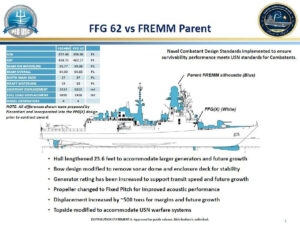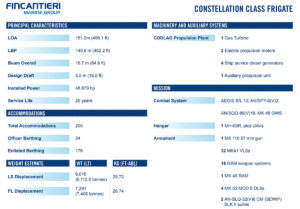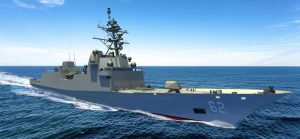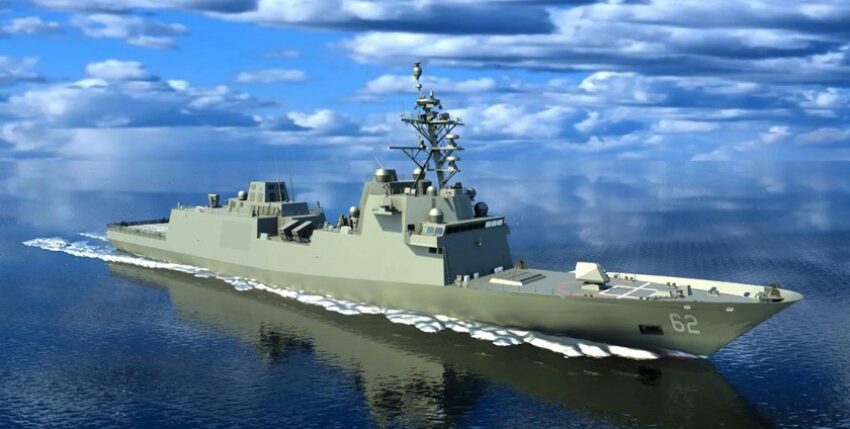Fincantieri's American subsidiary, Fincantieri Marinette Marine, began construction of the first Constellation-class frigate at the company's own shipyard in Marinette, Wisconsin, on 31 August 2022. According to the press release from the US Navy programme office responsible for the project, construction number 1, the "USS Constellation" (FFG 62), is scheduled for delivery in 2026. The class is also referred to as FFG 62 and FFG(X) in addition to the name of the first ship.
Start of construction delayed
Construction of the "USS Constellation" will begin almost two and a half years after Fincantieri was awarded the contract in April 2020. The programme managers explain this with the design review, which could only be completed in May 2022. The US Navy and Fincantieri adapted the design of the Italian FREMM multi-purpose frigate so that the Constellation-class frigates can be equipped with US systems such as Aegis Baseline 10 and C4I systems. The existing design was also revised to implement new capabilities and meet US Navy standards for assertiveness and survivability. This meant that work on the design took some time. In addition, there were numerous detailed solutions to comply with American standards, e.g. in the design of pipes, pumps and switches. Consultations with suppliers were necessary. It was all time-consuming. In the end, the shipyard only signalled the green light for the start of production in July 2022.

Bigger than its cousin
Compared to the Italian FREMM design, the Constellation class will be 7.13 metres longer (now 151.20 metres) and 1.10 metres wider at the waterline (now 18.1 metres). This increases the tonnage by approx. 520 tonnes to 7,400 tonnes. The sonar dome in the bow and the aft mast of the FREMM have been removed.
Specifications of the Constellation-class frigates
Compared to the specifications announced when the order was placed in 2020, it is noticeable that the helicopter equipment has been reduced to an MH-60 (Sikorsky Seahawk). However, the missile armament has been increased from eight to 16 NSMs.
The US Navy's first Constellation-class frigate (FFG-62) is to receive four diesel-electric propulsion units from MTU. Ficantieri Marinette Systems (FMM) has commissioned Rolls-Royce to supply the propulsion units (ESuT reported). The gensets (combi diesel engine with electric generator) are based on MTU 20V 4000 M53B engines, which deliver a total output of 12 MW for propulsion and on-board power supply.

Programme schedule and scope
In the meantime, the US Navy has already granted Fincantieri Marinette Marine contract options for two more units in the class. Most recently for the third frigate, USS Chesapeake (FFG-64) in June 2022. The order for the "USS Congress" (FFG-63) was already placed in 2021.
The Constellation-class frigates are a key component of the US Navy's NAVPLAN 2022 (Chief of Naval Operations Navigation Plan). This envisages a hybrid fleet of around 50 unmanned and 355 manned ships, including the twenty Constellation-class frigates that were already earmarked as new-generation frigates (FFG(X)) in the Pentagon's procurement plans. The Navy and the US Department of Defence have been working on specifying the 355-ship target since 2019. The Navy's 30-year plan (FY2023-FY2052) published on 20 April 2022 already contains the results of studies that recommend future fleets with 40 to 60 small surface combatants (SSC), which also include the FFG-62.
According to the current budget plan (FY 2023), which covers the financial years up to 2027, the US Navy is planning a procurement rate of 1-2-1-2. Originally, two ships per year were intended. The current rate is three ships every two years.
According to US Navy insiders, the procurement forecast corresponds to what a shipyard could build in the next five years. The identification of a second shipyard is on hold until all risks are analysed and documentation is completed by Fincantieri Marinette Marine. The US Congress has ordered a pause in this selection process.
According to reports from the US Naval Institute, both Ingalls Shipbuilding from Huntington Ingalls Industries and Austal USA are promising candidates for the award of further Constellation-class newbuilding contracts. The General Dynamics/Bath Iron Works consortium, the third US industrial team bidding, remains unmentioned.

Costs
In a report to the US Congress, the cost of the first unit is estimated at USD 1.281 billion. Construction number 2 is expected to cost USD 1.053 billion, construction numbers 3 and 4 USD 1.09 billion each. The price difference between the first and the other units is due to the fact that the development costs are added to the first unit in the US budget system. The slight increase from construction number 2 onwards can be explained by the general price trend. The budget figures include the equipment shares.
The pure construction costs are lower: when the contract for the construction of the "USS Chesapeake" (FFG-64) was awarded, a contract value of 537 million dollars was agreed with the shipyard.
Fincantieri's wave of success
Fincantieri has recently achieved significant successes with the delivery of FREMM-class frigates to Egypt, the contract in Indonesia for the delivery of six units of the same series, as well as the modernisation and sale of two Maestrale-class frigates, including logistical support for both programmes. The Italians are also cooperating with Daewoo Shipbuilding & Marine Engineering (DSME) on the conceptual design of the new aircraft carrier "CVX" for the South Korean Navy.










